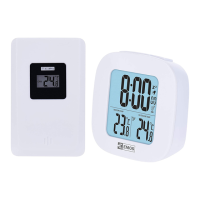7
If the clock does not detect the signal, follow these steps:
1. Move the thermometer to another location and try to detect the
DCF signal again.
2. Check the distance of the thermometer from sources of interference
(computer monitors or television sets). It should be at least 1.5 to
2 m during the reception of the signal.
3. When receiving DCF signal, do not put the thermometer in the prox-
imity of metal doors, window frames and other metal structures or
objects (washing machines, dryers, refrigerators etc.).
4. In reinforced concrete structures (cellars, high-rise buildings etc.),
the DCF signal reception is weaker, depending on the conditions.
In extreme cases, place the thermometer close to a window in the
direction of the transmitter.
Reception of the DCF 77 radio signal is aected by the following factors:
• thick walls and insulation, basements and cellars,
• inadequate local geographical conditions (these are dicult to
assess in advance),
• atmospheric disturbances, thunderstorms, electrical appliances
with no interference elimination, television sets and computers
located near the DCF receiver.
Manual Setting of Time and Date
1. Long press the MODE button on the back of the thermometer.
2. Use the arrow keys / to set the time format (12/24 h), hours,
minutes, year, month, day, time zone.
3. Press the MODE button to move between the values.
4. Hold the up or down arrow to set values faster.
Switching °C/°F Temperature Units
Repeatedly pressing the / buttons will switch between °C or °F
temperature units.
Display Mode
Repeatedly pressing the MODE button will display: current time – alarm
time – date.
Alarm Settings
Long pressing the ALARM ON/OFF button and using the / buttons
will set the alarm time.

